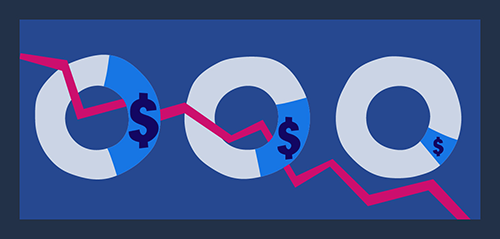BUYING INTO A MYTH?
Marketing Myth #2: Cutting marketing budgets is wise in a recession
With a looming trade war increasing the possibility of recession, corporate America is starting to cut back on marketing expenditures. But a growing body of evidence suggests that bad times are a good time to go on the offensive with your marketing – both in terms of advertising and new product launches.
Let history be your guide
During a recession, marketers who increase their Share of Voice (SOV) – i.e., their ad spending relative to competitors – tend to grow their market share and profits in the years following a recession.
From recession to long-term profitability
In his seminal study, Advertising in a downturn, marketing data scientist Peter Field found that cutting budgets in a recession only helps profits in the short term, with the brand ultimately emerging weaker and less profitable.3 Building on this study, he examined 50 brands during the Great Recession and found that both B2B and B2C companies succeed when their Share of Voice outpaces their Share of Market (SOM).
Other recent studies have echoed these findings. In one conducted during COVID, brands that increased spending saw 17% growth in incremental sales.5 In another by Boston Consulting Group, brands that decreased spending lost 6% in total shareholder returns and were 18% less likely to be recommended by consumers.6
Some things to consider before spending
Due to downward pressure on media costs and competitors spending less in a recession, you may be able to increase SOV even with a flat budget. That’s especially true today. With tariff uncertainty leading to additional budget cuts at many companies7 there is a big opportunity for others to fill the void and gain share, particularly those more insulated from tariffs like service providers (e.g., financial and insurance firms).
Got a new product? Don’t wait to roll it out.
Harvard Business Review points to a wide range of research that indicates “products launched during the recession have both higher long-term survival chances and higher sales revenues.”8 Why? Fewer product introductions from competitors. Plus, companies cast a more critical eye before greenlighting products in a difficult business climate.
If today’s uncertain economy has you questioning your marketing investments, let’s talk now ›
1 Forbes, “When A Recession Comes, Don’t Stop Advertising,” September 2019
2 Harvard Business Review, “Don’t Cut Your Marketing Budget in a Recession,” August 2020
3 Peter Field and IPA, “Advertising in a downturn,” 2009
4 Peter Field and LinkedIn B2B Institute, January 2021
5 Analytic Partners ROI Genome, “The Rules of Recession-Proofing,” 2022
6 Boston Consulting Group, “Don’t Cut Your Marketing Budget. Rethink It.,” January 2023
7 The New York Times, “Tariff Confusion Leaves Advertisers ‘Paralyzed’ and ‘Somber’,” April 16, 2025
8 Harvard Business Review, “Don’t Cut Your Marketing Budget in a Recession,” August 2020
Marketing Myth #1: Demand generation is king ›
Marketing Myth #3: Customer loyalty beats customer acquisition ›
Marketing Myth #4: Well-known brands don’t have awareness problems ›
Marketing Myth #5: B2B campaigns should be rational, not emotional ›
Marketing Myth #6: The purchase funnel is still a thing ›
Marketing Myth #7: Marketing is secondary to sales in B2B ›
Marketing Myth #8: Repeating what works will keep on working ›
Marketing Myth #9: Data-driven is always better than people-driven ›





 See what they have to say
See what they have to say